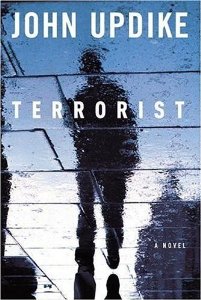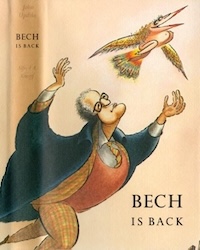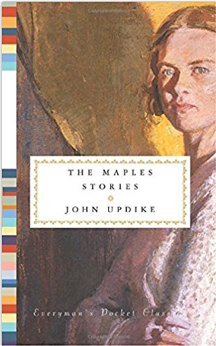 The New Yorker is taking the entire year to celebrate its centennial, and deservedly so. John Updike, whose first major publications were in those New Yorker pages, turns up quite a bit in the article by Jill Lepore on “The Editorial Battles that Made The New Yorker.” John Updike Society’s Dave Lull culled the sections that deal with Updike:
The New Yorker is taking the entire year to celebrate its centennial, and deservedly so. John Updike, whose first major publications were in those New Yorker pages, turns up quite a bit in the article by Jill Lepore on “The Editorial Battles that Made The New Yorker.” John Updike Society’s Dave Lull culled the sections that deal with Updike:
1—”Early in Adam Gopnik’s stint as a
New Yorker editor, he got a draft of a piece from
John Updike. It was perfect, so he set it aside. Soon, he got a typewritten postcard from Updike:
Dear Adam,
The piece recently submitted was
a) deemed unacceptable,
b) in need of significant rewriting,
c) lost behind a radiator.
John
Updike—even Updike!—had been feverishly awaiting a reply, Gopnik realized. ‘Was anything wrong with the Auden review?’ Updike once queried Shawn, scratching at the editorial door like a cat left outside for the night. ‘There has been an ominous gap since I turned it in.’ He wrote constantly, and brilliantly, submitting fiction, poetry, and criticism to the magazine over six decades. He got plenty of rejections, and sometimes, like every other self-loathing writer, he all but asked for them. ‘I enclose a disk,’ Updike once wrote to Finder, ‘but if you and Remnick are too let down, I will certainly understand.’”
2—”White later wrote to Updike, ‘Nabokov’s the best writer in English but sometimes he’s maddening and I do not like what his ego has done to make him so very complex.’ Updike once expressed the same kind of exasperation about a Nabokov novel: ‘There seem to be a lot of hostile parentheses.’”
3—”There’s a reason that Updike fretted so much. Other magazines print most of what their established contributors submit; from the start, The New Yorker refused to do that, rejecting submissions even from its star writers—sometimes for years—leaving many of them, especially fiction writers, in precarious financial straits.”
4—”In 1973, it was Updike who recommended that the magazine solicit a story from Chinua Achebe. Still, if you’re a piece of well-worn planking, you are keenly aware that your days as part of the ship are numbered. A good editor can put that fear to use, as Angell did with Updike. McGrath puts it this way: ‘Roger had a trick, when John hadn’t submitted anything in a while, of dropping a line to Updike mentioning that the magazine had just discovered a promising young writer, and as often as not, an Updike story would turn up in the mail a week or two later.’”
5—”Updike never saw that pasture. ‘I wanted to get this down to you before anything more befuddling befell me,’ he wrote to Finder from his sickbed, sending in what would be his last piece. ‘They must begin, surely, with chemo soon.’ He died the next month. He never lost so much as his fastball.”

 “Terrorist is cinematic and political—wonderfully so, as I read it. It may be as close to the movie Syriana as we’ll ever get from Updike.
“Terrorist is cinematic and political—wonderfully so, as I read it. It may be as close to the movie Syriana as we’ll ever get from Updike. British writer Diana Evans has written four acclaimed novels and, more recently, a collection of essays titled
British writer Diana Evans has written four acclaimed novels and, more recently, a collection of essays titled  The New Yorker is taking the entire year to celebrate its centennial, and deservedly so. John Updike, whose first major publications were in those New Yorker pages, turns up quite a bit in the article by Jill Lepore on
The New Yorker is taking the entire year to celebrate its centennial, and deservedly so. John Updike, whose first major publications were in those New Yorker pages, turns up quite a bit in the article by Jill Lepore on  “There are thus good arguments for the premise of John Updike’s Gertrude and Claudius that Hamlet’s father is the truly evil person in the play, and that his injunction to Hamlet is an obscenity. Updike’s novel is a prequel to Shakespeare’s play: Gertrude and Claudius are engaged in an adulterous affair (Shakespeare is ambiguous on this point), and this affair is presented as passionate true love. Gertrude is a sensual, somewhat neglected wife, Claudius a rather dashing fellow, and old Hamlet an unpleasant combination of brutal Viking raider and coldly ambitious politician. Claudius has to kill the old Hamlet because he learns that the old king plans to kill them both (and he does it without Gertrude’s knowledge or encouragement). Claudius turns out to be a good, generous king; he lives and reigns happily with Gertrude, and everything runs smoothly until Hamlet returns from Wittenberg and throws everything out of joint. Whatever we imagine as the (fictional) reality of Hamlet, Gertrude is the only kindhearted and basically honest person in the play.”
“There are thus good arguments for the premise of John Updike’s Gertrude and Claudius that Hamlet’s father is the truly evil person in the play, and that his injunction to Hamlet is an obscenity. Updike’s novel is a prequel to Shakespeare’s play: Gertrude and Claudius are engaged in an adulterous affair (Shakespeare is ambiguous on this point), and this affair is presented as passionate true love. Gertrude is a sensual, somewhat neglected wife, Claudius a rather dashing fellow, and old Hamlet an unpleasant combination of brutal Viking raider and coldly ambitious politician. Claudius has to kill the old Hamlet because he learns that the old king plans to kill them both (and he does it without Gertrude’s knowledge or encouragement). Claudius turns out to be a good, generous king; he lives and reigns happily with Gertrude, and everything runs smoothly until Hamlet returns from Wittenberg and throws everything out of joint. Whatever we imagine as the (fictional) reality of Hamlet, Gertrude is the only kindhearted and basically honest person in the play.” Nigel Beale, of The Biblio File podcast, posted an
Nigel Beale, of The Biblio File podcast, posted an  For this entry we need to thank writer
For this entry we need to thank writer 
 Coming in at #2 was Donald Sassoon’s Becoming Mona Lisa, which traces the path to superstardom of Leonardo da Vinci’s most famous subject/painting—a study that Brown said “suggests that, contrary to popular and scholarly belief, posterity is a peculiarly fickle thing.”
Coming in at #2 was Donald Sassoon’s Becoming Mona Lisa, which traces the path to superstardom of Leonardo da Vinci’s most famous subject/painting—a study that Brown said “suggests that, contrary to popular and scholarly belief, posterity is a peculiarly fickle thing.”
 It’s not exactly a doorstop, but at 186 pages, the Vol. 11 No. 1 (Winter 2024) issue of The John Updike Review is the largest to date. From the striking cover—a full-color photo of Updike with his father in a candid moment—to end pages that feature opportunities for writers and scholars, this issue has a lot to offer.
It’s not exactly a doorstop, but at 186 pages, the Vol. 11 No. 1 (Winter 2024) issue of The John Updike Review is the largest to date. From the striking cover—a full-color photo of Updike with his father in a candid moment—to end pages that feature opportunities for writers and scholars, this issue has a lot to offer.